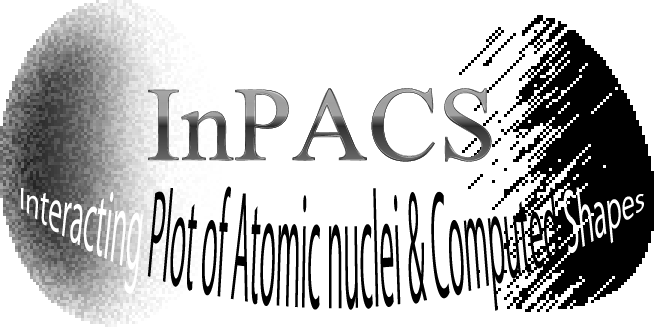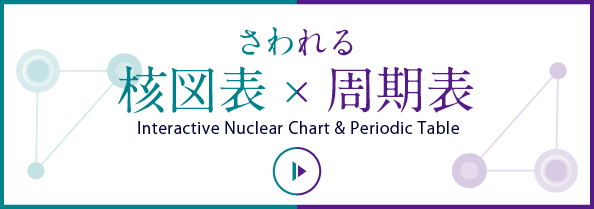

原子の中心に位置している「原子核」は、元素を決定し、物質の質量(重さ)を担っています。その大きさは原子よりはるかに小さく、およそ1兆分の1センチメートル。こんなミクロな世界でも、多数の粒子が集まって「形」が作られているのです。
Nucleus, at the center of an atom, determines the element and carries the mass (weight) of the matter. Its size is far smaller than the atom, about 1/1,000,000,000,000 cm. In such a microscopic world, many particles are gathering and forming the "shapes".
元素、原子と原子核
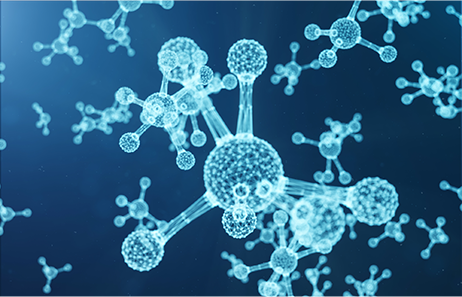
原子番号113番の元素が日本の理化学研究所で人工生成され、ニホニウムという名前と元素記号 Nh が付きました。そもそも「元素」とはいったいなんでしょうか。
古代ギリシャの四大元素説や古代中国の五行思想など、人類は古くから物質の素になるものを探し続けてきました。水素、炭素、酸素、鉄、鉛など、現在までに、100種類を越える数の元素が発見されています。気体、液体、固体、金属、植物、動物、... 、ありとあらゆる身の回りの物質は、すべて元素の組み合わせで作られています。
異なる元素には、異なる「原子」が対応していることを、人類は18世紀に突きとめます。原子は、これ以上分解できない物質の根源だと考えられていましたが、20世紀に入ると、原子の中心にはそれよりもはるかに小さな「原子核」があり、原子は原子核と電子からできていること、その原子核は陽子と中性子から作られていることが分かりました。
Elements, atoms and nuclei

A new element of atomic number 113 was artificially generated in RIKEN and named Nihonium with the element symbol Nh. To start with, what is the "element"?
The human race has been looking for basic elements of the matter. In ancient times, people believed theories like the four (five) elements in Greece and the Wu Xing in China. Now, we have found more than 100 kinds of elements, including hydrogen, carbon, oxygen, iron, lead, etc. The materials around us, such as gas, liquid, solid, metal, plants, animals, etc., are all made of combination of certain elements.
In the 18th century, we found that each element corresponds to each atom. Originally we thought that the atom could not be decomposed any further. However, in the 20th century, we have learned that there is a nucleus at the center of an atom, that the atom consists of a nucleus and electrons, and that the nucleus is made of protons and neutrons.
周期表
Periodic table
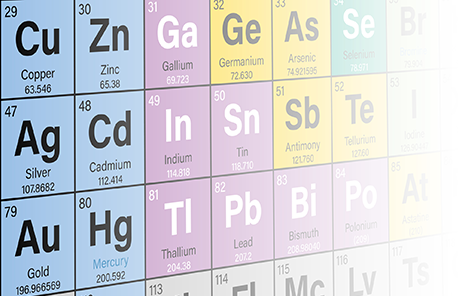
The element is determined by the number of protons (Z) in the nucleus. This is called atomic number. Since elements with different atomic numbers have different properties, we use different element symbols for them. The periodic table puts the elements in order of the atomic number: hydrogen (H) is the first, helium is the second, oxygen is the eighth, and so on, which means that the nucleus of hydrogen have one proton, the helium nucleus has two, and the hydrogen nucleus has eight protons. In this way, the element species is determined by the atomic nucleus. Furthermore, the weight (mass) of the element equals to that of the nucleus. Therefore, the weight of the materials on Earth is nothing but the weight of nuclei contained in the materials.
同位体、核変換
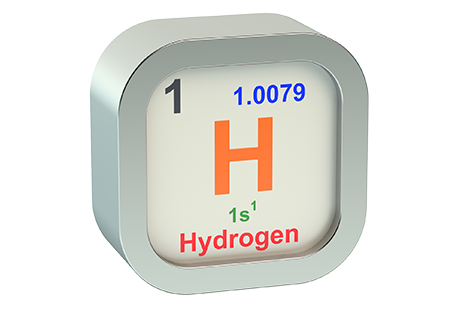
1つの元素に対応する原子核は1つではありません。例えば、水素には重水素と呼ばれる普通の水素よりも重い水素の原子が存在し、もっと重い三重水素(トリチウム)も存在します。これらは、同位体(アイソトープ)と呼ばれ、原子核中の陽子の数は同じ Z=1 ですが、中性子の数 (N) が異なっています。通常の水素は中性子ゼロ(N=0)、重水素は N=1、三重水素は N=2 で、原子核が異なっているのです。このうち、通常の水素と重水素は変化しませんが、三重水素の原子核は時間が経つとヘリウムの原子核に変化します。この変化は自然に起こる変換ですが、現代のテクノロジーを使うと、原子核を意図的に変換して別の元素や同位体に変えることが可能です。ただ、欲しい元素(同位体)を選択的に大量に作るということは難しく、未来に向けた課題と言えます。
Isotope, transmutation

There is no one-to-one correspondence between the element and the nucleus. For instance, in hydrogen, there exist deuterium and tritium which are heavier than normal hydrogen. These are called isotopes and correspond to different nuclei. Their nuclei have the same number of protons (Z=1) but different numbers of neutrons (N). The normal hydrogen has no neutron (N=0), the deuterium has one (N=1), and the tritium has two (N=2). Among these three kinds of hydrogen, the normal hydrogen and the deuterium do not change, but the nucleus of tritium changes into the helium nucleus in time. This change spontaneously takes place. Using modern technologies, we are able to intentionally change one nucleus to another, to produce different elements and isotopes. Nevertheless, it is difficult to produce massive elements (isotopes) selectively. This is a subject in future.
原子核を表す記号
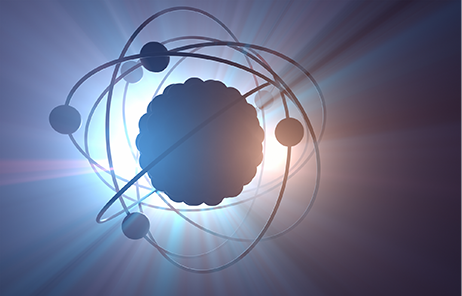
陽子の数 (Z) と中性子の数 (N) の組み合わせで原子核が決まり、その和を質量数 (A=Z+N) と呼びます。元素記号の左肩の上にAを書くのが習わしで、例えば、自然界に存在する炭素の約99%の原子核は Z=N=6で、12Cと書きます。1% ほど N=7 の 13C が存在し、さらにごくごく微量の 14C (N=8) が混ざっています。この 14C は、長い時間をかけてゆっくりと窒素 (14N) の原子核に変換されるため、炭素の中で 14Cの割合を調べることで、物質の年代を特定することができます (炭素年代測定)。
Symbol representing atomic nucleus

The proton number (Z) and the neutron number (N) determines the nucleus. The sum of Z and N is called mass number (A=Z+N). The nucleus is expressed by writing A in the upper left of the element symbol. For instance, about 99 % of carbon in nature has Z=N=6, which is denoted as 12C. About 1 % of carbon is 13C with N=7. In addition, there exist a tiny mixture of 14C (N=8). Since the 14C nucleus is slowly transmuted into nitrogen (14N), the ratio of 14C among the carbon isotopes can determine the age of materials (carbon dating).
核図表

元素1つに対して多くの同位体が存在するので、元素の種類よりもはるかに多くの核種が存在します。これまで人類が発見・同定した元素は120種類程度ですが、発見された原子核は3000種類程度、まだ発見されていないものが数千種存在すると予言されています。
元素の周期表のように原子核を並べてみましょう。陽子数 (Z) を縦軸、中性子数 (N) を横軸にとって平面上に配置すると、「核図表」と呼ばれるものになります。周期表の図で、好きな元素をクリックしてください。すると、その元素に対応する原子核が核図表の上でハイライト表示されます。縦軸の Z が元素の種類に対応するので、横1列がハイライトされるはずです。
一つの元素に沢山の同位体が存在していることが分かります。自然界の炭素は、12C と 13C (と微量の 14C) しか存在しませんが、加速器を使った実験によって、9C (N=3) から 22C (N=16) まで、同位体の存在が確認されています。自然界に存在しないこれらの同位体の原子核は、短時間で他の核種に変換してしまうため、「不安定核」あるいは「放射性同位体」と呼ばれます。
Table of Nuclides

There are much more nuclides than the number of elements, because each element has many isotopes. So far, we have found about 120 elements, while we have found about 3,000 nuclides and have predicted thousands of more nuclides yet to be discovered.
Let us put the nuclides in order similar to the periodic table. Arranging the nuclides on a plane with the proton number (Z) as the vertical axis and the neutron number (N) as the horizontal axis, this leads to the nuclear chart (the chart of nuclides). Click on any element on the periodic table. Then, the corresponding nuclei are highlighted on the nuclear chart. The nuclei with the same Z, namely a horizontal row should be highlighted.
Now, you can see there are many isotopes in each element. In nature, there are only 12C and 13C (with a tiny amount of 14C). However, experiments using accelerators have confirmed the existence of carbon isotopes, 9C (N=3) to 22C (N=16). The nuclei of these isotopes are transmuted into other nuclides in short terms, thus, they are called "unstable nuclei" or "radioactive isotopes".
原子核の形ってどんな形
What is the form of a nucleus

The nucleus is a microscopic object whose size is in femtometer (fm = 10-15 m) and whose volume is 1/1,000,000,000,000 of the atom. The world of nuclei is governed by the quantum mechanics that is very different from the natural laws we are used to in our daily life. However, even such microscopic objects, nuclei, have various shapes. What kind of shapes do they have?
On the Interactive Nuclear Chart, we show nuclear shapes calculated using the density functional theory and supercomputers. When you click on a nucleus, it shows the symbol of that nucleus and a figure of the nuclear shape. The nucleus can be rotated in the figure.


